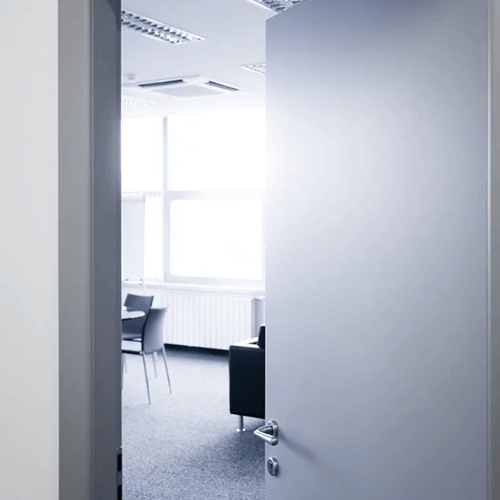
Commercial doors are available in a wide range of different sizes. While the most popular commercial door size is a standard 36-inch by 80-inch, that’s far from the only option. Depending on the specific area where the door is being used, the look your business is going for, and other factors, doors can come in a very wide range of sizes.
One of the most important aspects of determining the right commercial door size is keeping up with various building codes. There are many reasons why these codes can mandate a certain door size, whether due to disability legislation compliance or to ensure a proper means of egress.
The International Building Code is one of the most fundamental codes used around the world.
While it doesn’t hold the weight of law, many countries, states, and municipal building codes draw their standards directly from it. The International Building Code addresses construction standards for public health and safety goals and is established by the International Code Council.
The proper sizing for commercial doors is addressed in the International Building Code’s chapter on means of egress. The code sets a minimum of 32 inches for the clear width of the door. However, that isn’t the width of the door itself. Instead, it’s the open space available when the door is opened fully.
If a 36-inch door is installed such that it cannot open completely due to a 90-degree wall near the door, then the clear width of that door isn’t actually 36 inches. Instead, it is slightly less as the thickness of the door is taking up some of that clearance.
This reality is part of why 32-inch doors aren’t used as often as 36-inch doors. A 36-inch door leaves some wiggle room for clearance.
Minimum door heights are 80 inches — six feet eight inches. This height is very often the height used in commercial doors other than those doors installed for aesthetic reasons.
Fire safety codes are another important part of determining door sizes, and building owners can face serious legal penalties if they don’t meet standards. However, these codes can vary from state to state and between municipalities.
For example, Pennsylvania outlines its door standards in Pennsylvania Code 50.24 concerning means of egress. However, the standards used are the same as the International Building Code. A door must have a clear width opening of 32 inches and a minimum height of 80 inches.
Almost all fire codes will follow this same standard, but it isn’t a sure thing. Anyone choosing door sizes should make sure to double-check their state and municipal standards.
One major point to consider when choosing a door is whether you need to adhere to the Americans with Disabilities Act (ADA). If you need doors for a store or other areas open to the public, you almost surely do. Most workplaces of any kind must adhere to the act.
The act sets its own standards for door sizes based on accommodating individuals with disabilities. Doors at entrances must be at least 36 inches wide, which is a major factor in why that door width is so popular.
The ADA also has a number of additional requirements for doors. These include the use of levers in place of knobs, the height of the door lever, minimum distance to landings, and more. ADA requirements are all important things to keep in mind when ordering a commercial door.
The minimum door sizes are set by a variety of codes for health and safety. However, these codes don’t say anything about the maximum size of doors. Commercial doors are also available in a variety of larger sizes.
Larger doors are often used for stylish entryways. Double storefront doors are also very popular, with a range of options that can fulfill requirements easily and look great. Oversized wooden doors are a favorite for many types of professional offices — like law offices — where they add a little prestige and style.
If you need commercial doors that meet the relevant code requirements, you can rely on CDF Distributors. Our high-quality selection can meet any of your needs — just contact us today to get a quote.